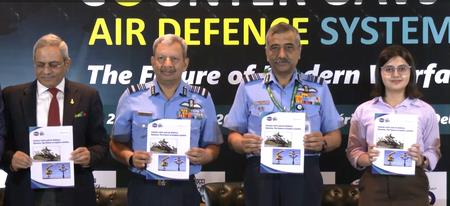
Counter-Uavs Key To Future Wars, Self-Reliance Crucial: Senior IAF Officers
His remarks came at the inaugural session of a conference on "Counter UAVs & Air Defence Systems – The Future of Modern Warfare", organised by the PHD Chamber of Commerce and Industry (PHDCCI) here.
Speaking to IANS, Air Marshal Dixit said: "During Operation Sindoor, we realised how important and crucial self-reliance can be. What we had envisioned became a reality... everyone is now highly motivated. We all want to develop indigenous systems. Even the Prime Minister spoke about Mission Sudarshan Chakra and the role of indigenous engines – we can only move forward by achieving self-reliance. In the future, all our projects will be implemented using our own indigenous methods."
On drones, he acknowledged that some components are still not manufactured in India but emphasised efforts to change that.
"We are trying to ensure that those components are also made in India. We have reformed our policies, and we are calling people and motivating them. For UAVs, an RFP (request for proposal) will be issued with a clear focus on Make in India," he added.
He further said that only a handful of countries in the world can design their own fighter aircraft or frigates, and India's progress towards self-reliance in such technologies is a "huge achievement".
Highlighting India's readiness, he noted: "We are always prepared for any situation. Indigenous content is increasing steadily, and through asymmetric warfare, we will be able to tackle diverse threats and secure our national security."
During his address at the event, Air Marshal Dixit also discussed the multi-layered approach needed for counter-drone systems, including radar, sensors, weapons, and integration with AI. He said hybrid warfare has made drones both a challenge and an opportunity, and cost-effective, fool-proof systems must be designed to give India the edge.
Deputy Chief of Integrated Defence Staff, Air Marshal Rakesh Sinha, echoed similar concerns. He said the landscape of warfare is witnessing a "seismic shift" due to the proliferation of drones, which have become a cornerstone of modern military strategy.
Citing the Russia-Ukraine conflict, he pointed out that 60–70 per cent of battlefield actions now involve unmanned aerial systems. "We have seen how a $1,000 drone can destroy or damage an aircraft worth $200 million. This asymmetric advantage is what makes drone warfare both transformative and dangerous. Ukraine today is producing 4.5 million drones annually," he said.
Both senior officers urged Indian industry and academia to step up innovation and ensure integration of indigenous technologies in drones and counter-UAV systems, underscoring that future wars will be defined by how effectively nations can counter the drone threat.

Legal Disclaimer:
MENAFN provides the
information “as is” without warranty of any kind. We do not accept
any responsibility or liability for the accuracy, content, images,
videos, licenses, completeness, legality, or reliability of the information
contained in this article. If you have any complaints or copyright
issues related to this article, kindly contact the provider above.


















Comments
No comment